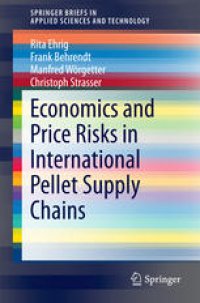
Ebook: Economics and Price Risks in International Pellet Supply Chains
- Tags: Energy Policy Economics and Management, Energy Economics, Environmental Economics, Environmental Engineering/Biotechnology
- Series: SpringerBriefs in Applied Sciences and Technology
- Year: 2014
- Publisher: Springer International Publishing
- Edition: 1
- Language: English
- pdf
The aim of this book is to investigate critical economic aspects and price risks along international pellet supply chains and to offer new insights into the interconnections between the sector, the various supply risks within the market and guidelines for de-risking biomass supply chains. It provides three real case studies as practical examples of determining actual supply costs from resource production to end-user and in doing so identifies and analyzes general economic performance indicators and price drivers for biomass supply chains. It also investigates the impact of several risks like raw material prices, exchange and freight rates on total prices. As a result, the reader learns how price risks are hedged to avoid project defaults and how to achieve the renewable energy targets of the end-user. Practical guidelines for recognising critical economic issues in biomass supply chains and for applying adequate de-risk strategies are also provided. Offering insights to a broad audience, this book is intended for researchers and professionals interested in renewable energy systems, biomass resource management and supply chain management. It also provides an invaluable resource to policy makers seeking guidelines for successfully managing the introduction of sustainable biomass projects.
The aim of this book is to investigate critical economic aspects and price risks along international pellet supply chains, and to offer new insights into the interconnections between the sector, the various supply risks within the market and guidelines for de-risking biomass supply chains. It provides three real case studies as practical examples of determining actual supply costs from resource production to end-user, and in doing so identifies and analyzes general economic performance indicators and price drivers for biomass supply chains. It also investigates the impact of several risks like raw material prices, exchange and freight rates on total prices. As a result, the reader learns how price risks are hedged to avoid project defaults and how to achieve the renewable energy targets of the end-user. Practical guidelines for recognising critical economic issues in biomass supply chains and for applying adequate de-risk strategies are also provided. Offering insights to a broad audience, this book is intended for researchers and professionals interested in renewable energy systems, biomass resource management and supply chain management. It also provides an invaluable resource to policy makers seeking guidelines for successfully managing the introduction of sustainable biomass projects.